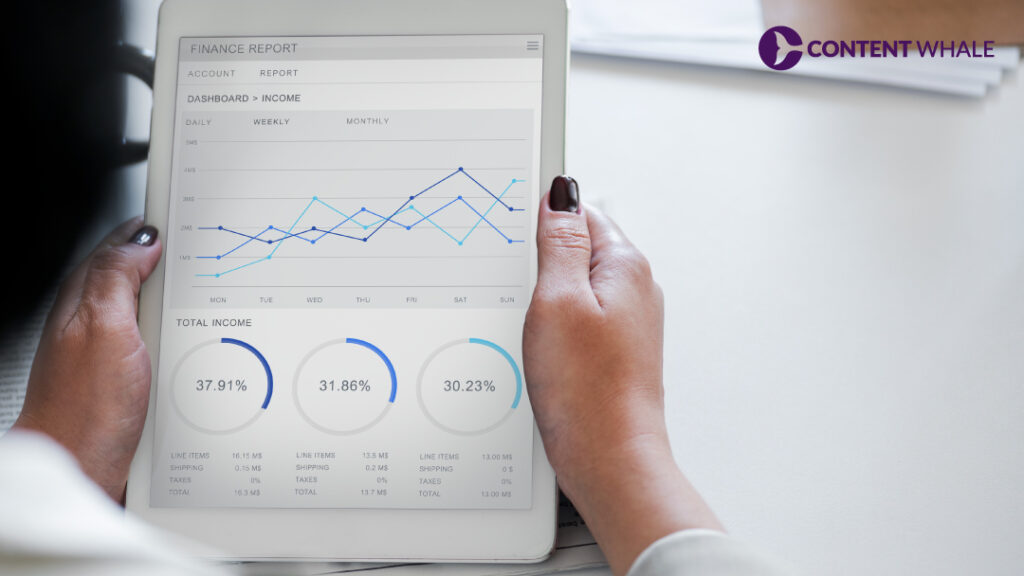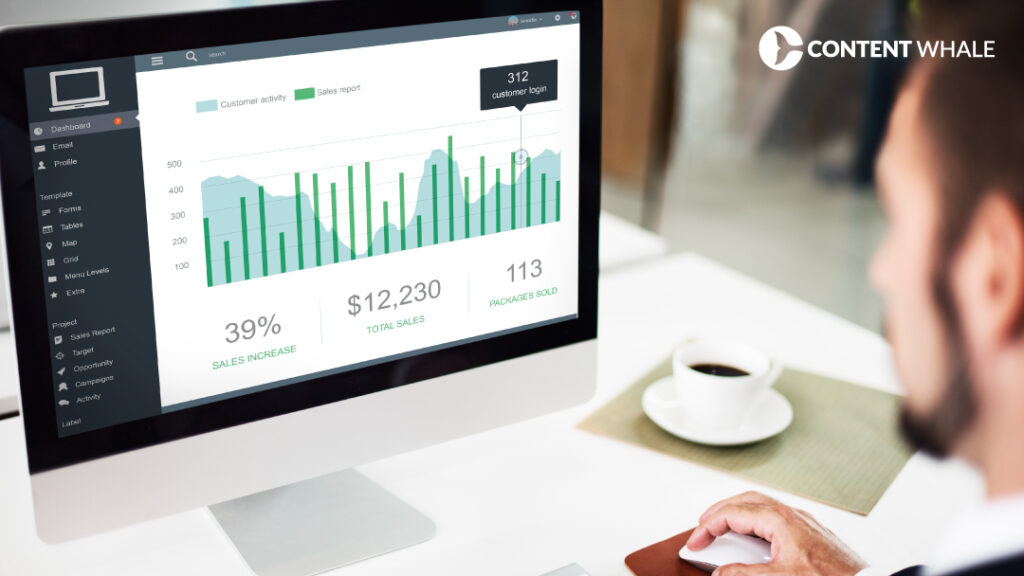Quick Summary
Understanding and tracking content marketing metrics is crucial for enhancing your digital strategy. This guide details six essential metrics: engagement, traffic, conversion, SEO, social media, and ROI metrics. By focusing on these key indicators, you can improve your content performance, make data-driven decisions, and optimize your marketing efforts. Tools like Google Analytics, SEMrush, and HubSpot provide valuable insights to measure and refine your content strategy, ensuring effective and impactful marketing campaigns.
Data-driven decisions have become a cornerstone of successful content marketing. By focusing on content marketing metrics businesses can fine-tune their strategies, ensuring every piece of content delivers maximum impact. Metrics guide content strategy, offering insights that help shape future content to better meet audience needs.
Tracking content performance is essential in today’s competitive market. With the right marketing analytics, you can understand what works and what doesn’t, allowing you to allocate resources effectively. These online metrics provide a clear picture of your audience’s behavior, helping you make informed decisions.
Research indicates that 50% of marketers plan to increase their investment in content marketing in 2024, reflecting the growing importance of data-driven approaches in the industry.
Additionally, 41% of marketers measure the success of their content marketing strategy through sales and web traffic, underlining the value of marketing measurement in achieving business objectives.
This blog promises to delve into six key content marketing metrics that are essential for improving your digital strategy.
These metrics will help you measure your success, optimize your efforts, and achieve your marketing goals. Stay tuned as we explore how these metrics can enhance your marketing measurement and drive your business forward.
1. Engagement Metrics

I) Understanding Engagement Metrics
Knowing how your audience interacts with your content is key to refining your content strategy. Engagement metrics provide insights into how well your content resonates with your audience.
These metrics include likes, shares, comments, and the time spent on a page. Each interaction offers data points that can help shape future content to better meet audience needs.
II) Key Indicators of Engagement
Likes, shares, and comments are direct indicators of audience engagement. A high number of likes and shares suggests that your content is reaching and resonating with your audience. Comments provide qualitative insights into audience thoughts and preferences.
By analyzing these interactions, you can gauge the content’s effectiveness and refine your strategy accordingly.
III) Time Spent on Page
Another crucial engagement metric is the time spent on a page. This metric indicates how long visitors stay engaged with your content, offering insights into its relevance and appeal. If visitors spend a significant amount of time on a page, it suggests that the content is valuable and engaging.
Conversely, a short time on page may indicate that the content did not meet the audience’s expectations or needs, signaling a need for improvement.
IV) Tools for Measuring Engagement
To measure these engagement metrics, tools like Google Analytics and social media insights are invaluable. Google Analytics can track time spent on pages, bounce rates, and other behaviors that inform your understanding of content performance.
Social media platforms provide their own analytics tools, offering detailed breakdowns of likes, shares, comments, and other interactions.
V) Integrating Engagement Metrics into Your Strategy
Audience engagement is not just about tracking numbers but understanding what they mean for your overall marketing strategy. High engagement rates are often linked to better SEO performance, as search engines favor content that engages users.
This correlation underscores the importance of integrating engagement metrics into your broader marketing analytics efforts.
VI) Setting and Tracking KPIs
Engagement metrics can help set and track key performance indicators (KPIs). These KPIs can reflect specific goals, such as increasing the number of shares or improving the average time spent on a page. By regularly reviewing these KPIs, you can make data-driven adjustments to your content strategy, enhancing its effectiveness over time.
Engagement metrics are a critical component of content marketing metrics. They provide a window into how your audience interacts with your content, offering insights that can drive improvements in content strategy and overall digital strategy.
By leveraging tools like Google Analytics and social media insights, you can track and analyze these metrics to continually refine your marketing efforts.
2. Traffic Metrics

I) Understanding Traffic Metrics
Traffic metrics are essential in evaluating the effectiveness of your content marketing efforts. These metrics provide insights into how many people visit your site and how they find it. Understanding traffic sources helps you refine your content strategy to attract more visitors and keep them engaged.
II) Types of Traffic Sources
Traffic sources can be categorized into several types: organic, direct, referral, and social traffic.
– Organic Traffic: This comes from search engines and is a key indicator of your SEO performance. High organic traffic suggests your content ranks well for relevant keywords.
– Direct Traffic: This includes visitors who type your URL directly into their browser. High direct traffic often indicates strong brand recognition.
– Referral Traffic: This comes from links on other websites. Referral traffic can highlight successful partnerships or mentions on other sites.
– Social Traffic: This includes visitors who come from social media platforms. Effective use of social media metrics can significantly boost this type of traffic.
III) Importance of Tracking Traffic Sources
Tracking where your traffic comes from is crucial for understanding audience behavior and optimizing your digital strategy. Knowing which sources drive the most visitors allows you to focus your marketing efforts on the most effective channels.
For instance, if a significant portion of your traffic is from social media, you might invest more in social media marketing.
IV) Tools for Measuring Traffic
Google Analytics is a powerful tool for tracking various traffic metrics. It provides detailed reports on the number of visitors, their behavior, and the sources of your traffic.
SEMrush is another useful tool that can help analyze your traffic sources, providing insights into your SEO metrics and overall online presence.
V) Analyzing Traffic Data
Regular analysis of traffic data is essential for ongoing improvement. Look for trends and patterns in your traffic metrics to understand what content performs best and why.
For example, a spike in organic traffic might indicate a successful SEO strategy, while an increase in social traffic could suggest effective social media campaigns.
VI) Using Traffic Metrics to Improve Content Strategy
Traffic metrics should inform your content strategy. If organic traffic is low, you might need to focus on improving your SEO efforts. If referral traffic is high, consider strengthening partnerships and seeking more backlinks. Consistently high direct traffic suggests that your brand is well-recognized, but it’s important to maintain this through continuous engagement and quality content.
Traffic metrics are a vital part of content marketing metrics, providing insights into how visitors find and interact with your site. By understanding and analyzing these metrics, you can refine your marketing strategies to attract more visitors and improve your content’s performance.
Tools like Google Analytics and SEMrush are essential for tracking and interpreting these metrics, helping you make informed decisions to enhance your digital strategy.
3. Conversion Metrics

I) What Are Conversion Metrics?
Conversion metrics are vital for understanding how effectively your content drives desired actions from your audience. These metrics help measure the success of your content marketing efforts in converting visitors into leads or customers.
Key conversion actions include newsletter sign-ups, downloads, and purchases.
II) Importance of Conversion Metrics
Conversion metrics are crucial for assessing content performance and overall marketing effectiveness. By tracking these metrics, you can understand how well your content fulfills its purpose, whether that’s generating leads, encouraging downloads, or driving sales.
These insights are essential for refining your content strategy and improving ROI in marketing.
III) Types of Conversions
Different types of conversions serve various business goals:
– Newsletter Sign-Ups: Indicates how many visitors are interested in receiving regular updates from your brand.
– Downloads: Measures the number of times visitors download resources like eBooks, whitepapers, or other gated content.
– Purchases: Tracks how many visitors complete a purchase, directly reflecting your sales funnel’s effectiveness.
IV) Tracking Conversion Rates
To track conversion rates effectively, it’s essential to set up proper tracking mechanisms using tools like Google Analytics and HubSpot. These platforms allow you to define and monitor conversion goals, providing detailed insights into user behavior and conversion paths.
For instance, Google Analytics can help you track how visitors navigate through your site and what actions they take, offering a comprehensive view of your conversion rates.
V) Improving Conversion Rates
Improving conversion rates involves optimizing various elements of your content and website. Here are some strategies:
– Optimize Call-to-Actions (CTAs): Ensure your CTAs are clear, compelling, and strategically placed.
– Simplify Forms: Reduce the number of fields in sign-up forms to make the process easier for users.
– Enhance User Experience: Improve website navigation and load times to keep visitors engaged.
– A/B Testing: Conduct A/B tests to determine which versions of your content perform better in driving conversions.
VI) Tools for Measuring Conversions
Several tools can help measure and analyze conversion metrics:
– Google Analytics: Provides robust tracking and reporting features to monitor various conversion actions.
– HubSpot: Offers comprehensive tools for tracking lead generation and customer conversion, integrating with your CRM for a holistic view of your marketing efforts.
VII) Using Conversion Metrics to Enhance Content Strategy
By regularly analyzing conversion metrics, you can make data-driven decisions to enhance your content strategy. For example, if a particular type of content leads to more conversions, you might focus on producing similar content. Tracking and analyzing these metrics helps you understand what resonates with your audience, allowing you to refine your approach for better results.
Conversion metrics are an essential part of content marketing metrics, providing insights into how well your content drives desired actions. By understanding and optimizing these metrics, you can enhance your marketing strategy and improve your overall content effectiveness.
Tools like Google Analytics and HubSpot are invaluable for tracking and analyzing conversion rates, helping you make informed decisions to boost your digital strategy.
4. SEO Metrics

I) Understanding SEO Metrics
SEO metrics are essential for evaluating how well your content is performing in search engines. These metrics help you understand the visibility and reach of your content, which is crucial for driving organic traffic to your site.
Key SEO metrics include keyword rankings, backlinks, and organic traffic.
II) Key SEO Metrics
– Keyword Rankings: This metric shows where your content appears in search engine results for specific keywords. Higher rankings generally lead to increased visibility and more organic traffic.
– Backlinks: These are links from other websites to your content. Backlinks are a strong indicator of content authority and relevance, significantly influencing SEO performance.
– Organic Traffic: This refers to the visitors who find your site through search engines without paid ads. Organic traffic is a primary goal of SEO efforts, reflecting the effectiveness of your content strategy.
III) Importance of Tracking SEO Performance
Tracking SEO metrics is vital for understanding how well your content is performing in search engines. High keyword rankings and a strong backlink profile can drive significant organic traffic, which is often more sustainable and cost-effective compared to paid traffic.
Monitoring these metrics allows you to adjust your content strategy to improve visibility and reach.
IV) Tools for Measuring SEO Metrics
Several tools can help track and analyze SEO metrics effectively:
– Ahrefs: This tool offers comprehensive insights into keyword rankings, backlink profiles, and competitor analysis.
– Moz: Provides detailed reports on keyword performance, backlink data, and site audits to help improve your SEO strategy.
– Google Analytics: While primarily used for web analytics, it also offers insights into organic traffic and how users interact with your site.
– Linkody: Specializes in backlink monitoring, helping you track, analyze, and disavow backlinks. It’s particularly useful for managing your link-building strategy and understanding your site’s link profile.
– SEOquake: A free browser extension that provides various SEO metrics, including backlinks, Google index updates, and keyword data. It’s handy for quick, on-the-go SEO analysis.
– Clearscope: This tool focuses on SEO content optimization, helping you create content that ranks well by analyzing top-performing pages and suggesting keyword usage and content structure.
– Sitechecker: This platform monitors your website’s SEO performance, including uptime, downtime, and keyword rankings. It also provides technical SEO audits and regular reports.
V) Using SEO Metrics to Enhance Content Strategy
By regularly analyzing SEO metrics, you can refine your content strategy to improve search engine performance. For instance, if certain keywords are performing well, you might focus on creating more content around those topics. Similarly, building more backlinks can enhance your site’s authority and improve rankings.
SEO metrics are a critical component of content marketing metrics, providing insights into how well your content performs in search engines. By tracking keyword rankings, backlinks, and organic traffic, you can optimize your content strategy for better visibility and increased organic traffic.
Here are some additional tools for measuring SEO metrics that can help enhance your content marketing strategy:
5. Social Media Metrics
I) Importance of Social Media Metrics
Social media metrics are essential for understanding how your content performs on various social platforms.
These metrics provide insights into your audience’s engagement, reach, and overall impact, which are critical for refining your content strategy and improving your marketing efforts.
II) Key Social Media Metrics
– Followers Growth: This metric tracks the increase in your social media followers over time. A steady growth in followers indicates that your content is attracting and retaining an audience.
– Engagement Rate: This measures the level of interaction (likes, comments, shares) your content receives relative to your follower count. High engagement rates suggest that your content resonates well with your audience.
– Reach: This metric shows how many unique users have seen your content. It helps you understand the breadth of your content’s exposure.
III) Using Social Media Metrics for Better Content Performance
Tracking these metrics helps you gauge the effectiveness of your social media strategy. For instance, a high engagement rate often correlates with high-quality, relevant content that meets your audience’s interests.
By analyzing which posts perform best, you can refine your content strategy to focus on similar topics or formats.
IV) Tools for Measuring Social Media Metrics
Several tools can help you measure and analyze social media metrics:
– Hootsuite: This platform provides comprehensive analytics for tracking engagement, reach, and followers growth across multiple social media channels.
– Sprout Social: Offers detailed reports on social media performance, including engagement rates, reach, and audience demographics.
– Buffer: Helps track the performance of your social media posts, providing insights into engagement, reach, and follower growth.
– Iconosquare: This tool is particularly useful for Instagram and Facebook marketers. Iconosquare offers in-depth performance analytics and streamlined content management, helping you boost engagement and growth on these platforms.
– Sendible: A comprehensive tool for social media monitoring and management, Sendible offers detailed analytics and reporting features. It’s designed for agencies and marketers who need to track performance across multiple social media channels.
– Zoho Social: An all-in-one tool for social media management, analytics, and reporting. Zoho Social helps you track the performance of your social media posts and provides insights into audience engagement and growth.
– Vista Social: An intuitive social media management platform that offers robust analytics and reporting features. Vista Social helps you understand your social media performance and optimize your content strategy.
Here is a table summarizing the tools:
| Tool | Primary Features | Best For |
|---|---|---|
| Hootsuite | Comprehensive analytics for tracking engagement, reach, and followers growth across multiple social media channels. | Comprehensive social media analytics. |
| Sprout Social | Detailed reports on social media performance, including engagement rates, reach, and audience demographics. | Detailed social media performance reporting. |
| Buffer | Tracks performance of social media posts, providing insights into engagement, reach, and follower growth. | Tracking post performance and growth. |
| Iconosquare | In-depth performance analytics for Instagram and Facebook, streamlined content management. | Instagram and Facebook marketing. |
| Sendible | Social media monitoring and management, detailed analytics and reporting, designed for agencies and marketers. | Agencies and marketers tracking multiple channels. |
| Zoho Social | All-in-one tool for social media management, analytics, and reporting, insights into audience engagement and growth. | Overall social media management and analytics. |
| Vista Social | Intuitive social media management platform with robust analytics and reporting features. | Understanding performance and optimizing content strategy. |
V) Enhancing Your Digital Strategy with Social Media Metrics
By integrating social media metrics into your broader marketing analytics, you can make informed decisions that enhance your digital strategy. Regularly reviewing these metrics allows you to adjust your content and posting schedules to maximize impact. Additionally, understanding these metrics helps in setting realistic key performance indicators (KPIs) and achieving your marketing goals.
Social media metrics are a vital part of content marketing metrics, offering insights into how well your content performs on various platforms. By tracking followers growth, engagement rate, and reach, you can refine your content strategy and improve your overall marketing effectiveness.
6. ROI Metrics
I) What Are ROI Metrics?
ROI metrics are critical for assessing the return on investment from your content marketing efforts. These metrics help you understand the financial impact of your content strategies and measure the effectiveness of your marketing campaigns.
By tracking ROI, you can determine whether your investments in content creation, distribution, and promotion are yielding profitable results.
II) Importance of ROI in Marketing
Measuring ROI is essential for justifying marketing spend and optimizing your budget allocation. High ROI indicates that your content marketing efforts are effective and generating significant returns relative to the costs involved. Conversely, low ROI can signal the need to reevaluate your content strategy and marketing tactics.
III) Calculating ROI
To calculate ROI, use the following formula:
\[ \text{ROI} = \left( \frac{\text{Revenue} - \text{Cost}}{\text{Cost}} \right) \times 100 \]
For instance, if your content marketing campaign generated $10,000 in revenue and cost $2,000, the ROI would be:
\[ \left( \frac{10,000 - 2,000}{2,000} \right) \times 100 = 400\% \]This means that for every dollar spent, you earned four dollars back.
IV) Tools for Measuring ROI
Several tools can help you track and measure the ROI of your content marketing efforts:
– Google Analytics: Offers comprehensive tracking of website traffic, conversion rates, and revenue generated from your content. It helps you understand which content pieces are driving the most value.
– HubSpot: Provides integrated tools for tracking lead generation, customer conversion, and revenue attribution. HubSpot’s detailed reports help you connect your marketing efforts directly to ROI.
V) Using ROI Metrics to Improve Content Strategy
Regularly analyzing ROI metrics allows you to make data-driven decisions and refine your content strategy. For example, if certain types of content or channels consistently yield high ROI, you might focus more resources on those areas. On the other hand, low-performing content can be optimized or discontinued to ensure better resource allocation.
ROI metrics are an essential part of content marketing metrics, providing insights into the financial effectiveness of your marketing efforts. By understanding and optimizing these metrics, you can enhance your marketing strategy and improve your overall content effectiveness.
Tools like Google Analytics, HubSpot, and Sprout Social are invaluable for tracking and analyzing ROI, helping you make informed decisions to boost your digital strategy.
Conclusion
Tracking content marketing metrics is vital for making data-driven decisions that enhance your content strategy. By understanding and measuring these metrics, you can gain insights into your content performance and overall marketing effectiveness. This approach allows you to optimize your digital strategy, ensuring that your content resonates with your audience and drives desired actions.
Using tools like Google Analytics, SEMrush, and HubSpot can significantly improve your marketing measurement efforts. These tools help you track key performance indicators, SEO metrics, conversion rates, and more, providing a comprehensive view of your content’s impact.
At Content Whale, we specialize in providing comprehensive content marketing services that help businesses succeed in their digital strategies. Our expertise in marketing analytics ensures that your content is not only engaging but also effective in achieving your marketing goals. Contact us today to learn how we can help you enhance your content strategy and achieve better results.
FAQ
What are content marketing metrics?
Content marketing metrics are measurements used to evaluate the effectiveness of your content marketing efforts.
These metrics help you understand how well your content performs in terms of engagement, reach, conversions, and ROI.
Why are engagement metrics important?
Engagement metrics are crucial because they show how your audience interacts with your content.
High levels of likes, shares, comments, and time spent on page indicate that your content resonates well with your audience, helping you refine your content strategy.
How can I measure traffic to my content?
You can measure traffic to your content using tools like Google Analytics and SEMrush. These tools provide detailed insights into the sources of your traffic, including organic, direct, referral, and social traffic, helping you understand your audience’s behavior.
What tools can I use to track SEO metrics?
Tools like Ahrefs, Moz, and Google Search Console are excellent for tracking SEO metrics. They provide data on keyword rankings, backlinks, and organic traffic, helping you optimize your content for better visibility in search engines.
How do I calculate ROI in content marketing?
To calculate ROI in content marketing, use the formula:
\[ \text{ROI} = \left( \frac{\text{Revenue} - \text{Cost}}{\text{Cost}} \right) \times 100 \]Tools like Google Analytics and HubSpot can help track the revenue generated from your content efforts, allowing you to determine the profitability of your marketing campaigns.





